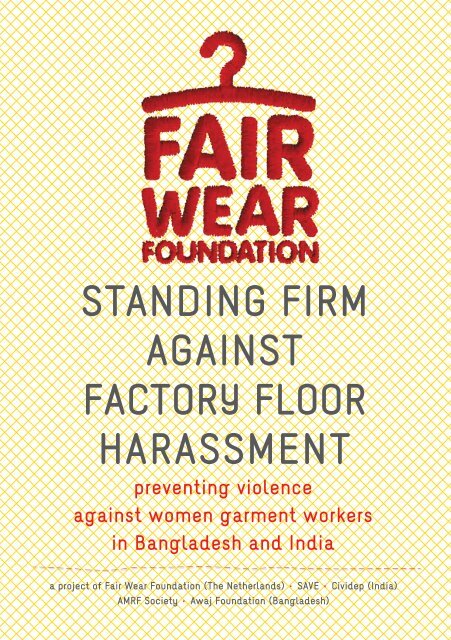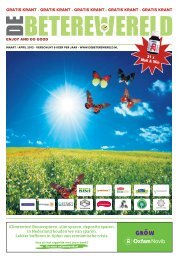STANDING FIRM AGAINST FACTORY FLOOR HARASSMENT
report - Fair Wear Foundation
report - Fair Wear Foundation
- No tags were found...
Create successful ePaper yourself
Turn your PDF publications into a flip-book with our unique Google optimized e-Paper software.
<strong>STANDING</strong> <strong>FIRM</strong><br />
<strong>AGAINST</strong><br />
<strong>FACTORY</strong> <strong>FLOOR</strong><br />
<strong>HARASSMENT</strong><br />
preventing violence<br />
against women garment workers<br />
in Bangladesh and India<br />
a project of Fair Wear Foundation (The Netherlands) . SAVE . Cividep (India)<br />
AMRF Society . Awaj Foundation (Bangladesh)
fair wear foundation<br />
This project has been made possible by the support of the United Nations Trust<br />
Fund to End Violence against Women and the Dutch Ministry of Foreign Affairs.<br />
copyright © 2013 Fair Wear Foundation<br />
Amsterdam, The Netherlands<br />
standing firm against<br />
factory floor harassment
introduction<br />
Violence against women is one of the most widespread violations of human rights.<br />
Some form of harassment or violence – ranging from verbal and physical abuse and<br />
sexual harassment, to forced labour, assault and rape - has been reported by a disturbingly<br />
high percentage of garment workers. The good news is that workplace violence<br />
against women in the garment industry in India and Bangladesh is being increasingly<br />
acknowledged as a serious problem.<br />
It is women who suffer the greatest damage, but workplace violence has negative<br />
consequences for all parties involved. Hostile working conditions lead to low productivity<br />
and high worker turnover. It also limits the potential contributions of millions of<br />
women workers to the broader society and economy.<br />
The Preventing Workplace Violence project is an innovative partnership between Indian<br />
and Bangladeshi garment factories, European clothing brands, governments, civil society<br />
organisations and trade unions in Europe and Asia. Together, they are piloting new<br />
ways to address and remedy the root causes of workplace violence.<br />
‘Garment factories are places of dirty language and abuse. Those who have done<br />
a lot of sinning come here for penance.’ – a garment worker in Bangladesh.<br />
workers speak up<br />
Indian and Bangladeshi laws are very clear on the steps to be taken in workplaces to<br />
prevent and remedy violence against women. However there are no documented examples<br />
of factories where the laws are being properly implemented. In 2011, Fair Wear<br />
Foundation (FWF) and local NGOs in Bangladesh and India launched an effort to fully<br />
implement these laws in garment factories. In 2013, the laws in India were strengthened<br />
by the passage of the Sexual Harassment of Women at Workplace Act, and the<br />
project became among the first efforts in any industry to implement the new law.<br />
Despite many challenges, the project is proving successful: factories are allowing training<br />
for workers and managers on the importance and benefits of treating women better;<br />
several anti-harassment committees and telephone helplines have been established;<br />
workers are speaking up about problems; and factories and clothing brands are working<br />
together to remedy those problems. The project is also providing rare insight and<br />
solid documentation of a problem which is rarely spoken about.<br />
4 5
FWF in Bangladesh<br />
‘easy prey’<br />
Sumi* (23) always dreamed of having a good job and liked going to school very much.<br />
But her family was poor and decided to move from the countryside in Bangladesh to<br />
Dhaka in the hope of improving their situation. 14-year-old Sumi took a job in a garment<br />
factory.<br />
Everything was going well with Sumi at work until one day a couple of her male<br />
colleagues tried to abduct her from just in front of the factory gate. ‘I screamed and<br />
cried for help. Luckily some bystanders came over. I was hurt, but rescued.’<br />
unsafe abortion<br />
Sumi found a new job and after six years she is proud to be a senior sewing machine<br />
operator. Sumi got married to a line chief from the same factory. ‘My husband has not<br />
informed his family about our marriage yet. He fears that his family will not accept me<br />
if they find out about my profession.’<br />
She got pregnant, but her husband didn’t want her to keep the child. ‘So I went for an<br />
unsafe abortion. I was not treated well and had a bad infection. Since then I’ve had<br />
many complications. I’m scared that someday my husband might leave me.’<br />
Sumi has heard many stories about sexual harassment in different workplaces. Women<br />
workers are also harassed on the way to work. When they’re unprotected, she believes<br />
that people treat them as ‘easy prey’. The factory where she currently works treats<br />
women well.<br />
a man’s job<br />
‘In the factories where I used to work, women are not treated as human beings. It’s as<br />
if women workers are born to take orders from men. Men feel like they can touch them<br />
anywhere they want and use any kind of language.’<br />
Sumi’s factory offered her the position of line supervisor, but she refused. She is<br />
scared of taking on managerial responsibilities; to her, that is a man’s job. She just<br />
wants to be happy and save some money.<br />
* For reasons of privacy, the names of the people interviewed in this report have been changed.<br />
6 7<br />
The people portrayed in the interviews are not those shown in the photos.
acknowledging<br />
a problem<br />
Offensive and sexually explicit language, hitting, hearing suggestions to become a<br />
prostitute, slapping on heads, pulling of hair; all are examples of abusive behaviour<br />
reported by garment workers. Millions of women have experienced this type of treatment<br />
because they made a mistake, failed to meet a production target, asked for leave,<br />
worked slower because of illness, or arrived late. Many women have also experienced<br />
unwanted sexual advances in the workplace, stalking, or worse, from male colleagues<br />
or supervisors.<br />
These issues have long been a part of life in garment factories, but until recently the<br />
problems have rarely been reported. Often, neither senior factory managers nor their foreign<br />
customers were aware of the level of harassment. How is this possible? Several<br />
factors contribute to the ‘hidden’ nature of workplace violence.<br />
female workers have been reluctant to speak up about harassment<br />
They see it as unfair and deeply disturbing, but inevitable and an extension of the<br />
‘normal’ behaviour they experience outside of work. They feel ashamed and embarrassed,<br />
and historically have kept silent for fear of making things worse, risking their<br />
reputations, or damaging their marriage prospects. The reporting of harassment or<br />
sexual or physical violence remains rare.<br />
harassment and violence is difficult to detect in factory audits<br />
A reluctance to report incidents and a belief that harassment is ‘normal’ makes it difficult<br />
to detect harassment in factory audits, even using FWF’s offsite worker interview<br />
system. Project partners had anecdotal evidence of widespread problems and<br />
some research had pointed in a similar direction. However, it was not until this programme<br />
invested significant time in educating, speaking with, and earning the trust<br />
of, workers that the true scale of the problem started to come into focus.<br />
8 9
senior management may not see the problems<br />
One of the most telling statistics found in the project’s baseline research regards perceptions<br />
of yelling: only 20% of managers thought there was a lot of yelling in factories;<br />
60% of workers thought it was common. Workers also reported that the vast majority<br />
of problems are with their immediate supervisors, who can change their behaviour<br />
when senior managers are on the factory floor. There is also a perception among many<br />
managers that while women may be yelled at, or occasionally hit, the environment is<br />
still preferable to other options available to poor uneducated women – like prostitution.<br />
The partners believe that a different frame of reference is more appropriate: Harassment<br />
of the type reported by many garment workers would never be tolerated in the stores<br />
where garments are sold; so why should it be tolerated in the factories where the garments<br />
are made?<br />
traditional systems to report problems are not trusted<br />
Recent Indian and Bangladeshi anti-harassment laws are clearly designed<br />
to address the shortcomings of traditional complaint systems. As several<br />
workers noted: ‘There is a complaint box but it does not work because it’s<br />
never opened.’ ‘Everyone is encouraged to submit complaints. But when I have<br />
a problem and want to see the administrator, the line chief does not<br />
allow me to meet him.’ And 95% of garment factories in India and<br />
Bangladesh are not unionized; so any reporting via unions is<br />
rarely possible.<br />
India<br />
Sumangali<br />
Under the Sumangali scheme, a form of forced labour common in Tamil Nadu, India,<br />
girls’ parents are persuaded by brokers to sign up their daughter(s). These families<br />
are usually poor and from the lower castes. The scheme promises an attractive sum<br />
of money after completion of a three-year contract working in the factory.<br />
Once the contract is signed, young girls are under the control of the factory or the<br />
broker. It is often reported that the girls live in captivity for a long period. Girls are<br />
often forced to work up to 12 hours a day, live in hostels with few facilities, and<br />
earn a very low wage.<br />
Approximately 60% of the factory<br />
workers have experienced some<br />
type of harassment at work, verbal<br />
abuse or physical abuse.<br />
Bangladesh<br />
who are the workers?<br />
Garment workers in India and Bangladesh are mostly under the age<br />
of 20. They migrate from mostly small, traditional villages in poorer<br />
states with high unemployment, to major textile hubs. Often they<br />
cannot read or write.<br />
They are usually the first generation working in a factory and away<br />
from home. Their parents know nothing about life in a factory and can<br />
provide little guidance. The women need income and their family is<br />
counting on them.<br />
70%<br />
of the 7 million<br />
workers are female<br />
80%<br />
of the 3.6 million<br />
workers are female<br />
10 11
FWF in India<br />
harassment happens all the time<br />
- just not to us!<br />
On the outskirts of Tirupur, we are to meet a group of garment workers at one of their<br />
homes after the end of their shift. Six women gather around us on a porch facing onto<br />
a small yard. Five of them work as ‘checkers’ which is among the lowest-paid jobs in<br />
the Tirupur garment factories.<br />
One woman called Ramya started out as a ‘helper’ to a tailor. As she had some relatives<br />
working in the factory, the tailor left her alone, but the other girls were harassed mercilessly:<br />
‘The tailor would slap them, prick them with his needle and even kick them, for<br />
no reason at all.’<br />
The other women chip in: they too have witnessed this kind of harassment throughout<br />
their working lives. But all of them deny having ever been subjected to it. Nobody has<br />
ever been shouted at? ‘Yes, every day!,’ Ramya responds. ‘Supervisors shout at us and<br />
humiliate us all the time. It makes us feel really bad. We don’t like to talk about it.’<br />
keep quiet<br />
‘Sometimes the shouting is justified; when we’ve made a mistake, or been wasteful,’<br />
Ramya explains. ‘When that’s the case, we simply accept the shouting and apologise.<br />
But when it’s unjust…’ ‘We just keep quiet anyway!,’ her neighbour interrupts her.<br />
What about sexual harassment? They giggle. ‘We’re way too old for that! When we<br />
were young – before we were married – the men would tease us. When we would hand<br />
the tailor or supervisor an item of clothing, for example, they’d grab our hand and<br />
stroke it.’<br />
As we prepare to leave, I ask the four women who have daughters how they would feel<br />
if their daughters would end up working in a garment factory. ‘No way,’ one of them<br />
answers, ‘we would never want them to suffer the things we have endured!’<br />
12 13
steps towards a solution<br />
No clothing brand wants sexual harassment or abuse against workers in their supply<br />
chains. No factory owner wants to be known as allowing abuse to take place in<br />
his or her factory. When no problems related to harassment are being reported, the<br />
easy response is to conclude that there are no problems. However, research shows<br />
that harassment is often a hidden issue.<br />
The United Nations Framework on Business and Human Rights emphasizes the<br />
importance of ‘human rights due diligence’ – identifying and remedying possible<br />
human rights problems in supply chains, even if those problems are not immediately<br />
obvious. The participants in this project are currently providing examples of<br />
how to carry out such due diligence.<br />
clothing brands<br />
Clothing companies increasingly realize that they need to take action to address violence<br />
on the factory floor. No company can afford to ignore sexual harassment because of the<br />
negative effects on the workforce and the potential reputational damage.<br />
For European clothing brands involved in the project, preventing violence against<br />
women is part of their business negotiations with factories. They turn violence from<br />
a social issue into an issue with economic consequences for factory managers.<br />
’We have to handle our workers very carefully because there is another factory next door. Workers<br />
will immediately leave if they feel they are not being treated properly. We agreed to pilot an antiharassment<br />
committee with Fair Wear Foundation because the brand we supply asked me to and<br />
also because we want to ensure a stable workforce.’ – Indian factory director<br />
Kwintet (Swedish FWF member since 2010)<br />
’Increasing the awareness of top and middle management, as well as<br />
employees, usually brings the necessary break-through in ensuring a<br />
good working environment in the factory. All levels in the factory are<br />
positive about the training sessions and express an increased understanding<br />
afterwards as to why good industrial relations are important<br />
and why it is a win-win situation for all the involved stakeholders.’<br />
McGregor Fashion Group (Dutch FWF member since 2007)<br />
’Due to the fact that most workers in garment factories are women, and<br />
that the harassment rates against women in the garment industry must<br />
be taken seriously, we truly believe that our participation in this project<br />
is part of our corporate social responsibility (CSR).‘<br />
14 15
preventing workplace violence:<br />
how the programme works<br />
The programme is designed to provide factories with the tools they need to implement<br />
anti-harassment laws, and workers with the knowledge required to use the<br />
systems provided for by the law. There are three major elements:<br />
training courses<br />
With the support of FWF member brands, the project’s local partners provide training to<br />
workers. This training includes basic rights, an outline of the anti-harassment laws, and<br />
information on worker helplines.<br />
Training is also given to senior managers to explain the project, to secure their buy-in,<br />
to explain the laws, and to explain how a functional complaint process can lead to<br />
lower worker turnover and better productivity. One of the unique aspects of this project<br />
is that the training is held with the full knowledge and permission of factory managers.<br />
The project is designed to provide training to over 30,000 workers over three<br />
years.<br />
anti-harassment policies and committees<br />
The law calls for the election and creation of elected anti-harassment committees (AHCs)<br />
who can file grievances on behalf of garment workers who have experienced harassment.<br />
They work with managers to ensure that cases are resolved appropriately. Factories are<br />
required to create policies to address complaints and reduce overall harassment.<br />
Local NGOs and trade unions provide support and counselling when needed. If necessary,<br />
there are linkages to law enforcement agencies for the prosecution of major violations.<br />
worker helplines<br />
In cases when workers have questions about their rights, or when<br />
the anti-harassment committees are not yet functional, they can<br />
also call the FWF helpline. FWF requires member companies to negotiate<br />
a solution to complaints filed this way, and publically reports<br />
on how brands resolve the complaints.<br />
committee at work:<br />
in a big training room in a factory in Tirupur…<br />
… forty girls and young women sing a song about standing firm against harassment.<br />
A few of them move to the middle of the room and start performing a skit: one girl plays<br />
a drunken husband who is hitting his wife and preventing their daughter from going to<br />
school. The wife does not accept his behaviour, raises her voice and stands tall.<br />
Together, these forty women form the factory’s anti-harassment committee. They were<br />
elected by their peers: the factory’s employees were divided up into groups of ten, which<br />
each group choosing one person to represent them in the committee.<br />
Since the start of the project training, they say, they’ve learned a lot about harassment<br />
and how to deal with it. They haven’t had to deal with actual harassment complaints<br />
yet, but just recently, one of the committee members was called in for help when a<br />
worker was self-harming, inflicting severe scratches on herself. Now she is providing<br />
support to the girl, making sure she is monitored.<br />
nervous looks<br />
The committee members agree that this kind of issue helps establish their position, even<br />
if it doesn’t involve actual harassment. They’re sure that if any harassment were to happen,<br />
their colleagues would know they can approach them.<br />
They know that their supervisors have received some training as well. But it hasn’t<br />
changed them much yet. And besides, they say that there is no harassment at this factory<br />
– throwing nervous looks at each other when the question is asked. The interview<br />
setting does not help them open up, facing the interviewer, photographer and translator.<br />
Two management representatives are also present, one on either side of the<br />
women.<br />
Only one woman has the courage to raise her hand when I ask if nobody dreams of being<br />
a factory manager. She looks around proudly when the other girls give her a round of<br />
applause. When she is factory manager, she promises, she will make sure that the women<br />
working for her are heard.<br />
FWF in India<br />
16 17
esults<br />
The training courses are bringing some early success, and three major themes<br />
have emerged during the first two years of this three-year project.<br />
increased worker knowledge<br />
Increased confidence is measured in being able to deal with harassment on a daily<br />
basis and having a clearer understanding that they have a right to be free from violence.<br />
Workers reported that they were more confident about raising problems and<br />
solving problems together with managers.<br />
anti-harassment committees<br />
The election of the first group of anti-harassment committees is a major step towards<br />
better dialogue between workers and managers. Given the sensitive nature of harassment<br />
issues, it will take time for fully functional committees to develop, and for<br />
the most effective strategies for their management to emerge. The learning curve<br />
for both workers and managers is significant, however valuable lessons are already<br />
being learned.<br />
18 19
Results<br />
Initially, as expected, workers reported relatively minor issues. However, as worker trust<br />
in the systems grows, reports about more serious issues are likely.<br />
For example, during a few successful interactive AHC meetings in various Indian<br />
factories, issues of female workers who were being teased by male colleagues,<br />
were discussed. When an official complaint was filed, both the AHC members<br />
and the management immediately approached the workers concerned and warned<br />
them to stop. After that the victim was left alone – a small but significant milestone<br />
for this factory.<br />
Nudie Jeans (Swedish FWF member since 2009)<br />
‘It is important to facilitate that these kinds of project reaches employees<br />
who really benefit from it and have limited chances to get the<br />
knowledge from elsewhere.<br />
So far it seems to be working quite well. The training sessions are regular<br />
and they have set up functioning committees with representatives<br />
from different departments to deal with employee concerns.’<br />
project milestones<br />
• Training to top management staff at 54 factories<br />
• 3,500 workers have been directly trained at 24 factories<br />
• 15,000 workers have been trained via peer-to-peer education<br />
• Eight anti-harassment committees have been set up<br />
• After the training, 97% of the workers felt ‘more knowledgeable’<br />
about violence at their workplace<br />
• Three anti-harassment telephone helplines have been established, operated<br />
by local partners, affiliated to FWF’s existing helpline system<br />
• So far, the Bangladesh helpline received 45 phone calls from workers in several<br />
different factories. Many were inquiries about laws and regulations, however<br />
10 complaints were filed concerning labour rights violations<br />
• It has taken longer for workers in India to begin using the helpline, however<br />
the first few complaints have also been filed in recent months, and growth is<br />
expected as word spreads among workers that the helplines are effective<br />
’After setting up the anti-harassment committees, there have been fewer problems.<br />
Bad attitudes can affect production.’ – Indian factory manager<br />
20 21
‘I’m not the father’<br />
Shatil Ara, Fair Wear Foundation Bangladesh office, about training workers<br />
‘In Bangladesh, harassment is culturally defined. Men are powerful. Women are in the<br />
bottom groups. Only excessive actions are actually recognized as harassment. Our first<br />
goal during our factory training courses is to understand and underline the root causes<br />
of harassment.<br />
During a role play, sometimes a worker will play a pregnant woman who asks the manager<br />
if she can leave because she’s not feeling well. It’s odd to say you’re pregnant in a<br />
garment factory in Bangladesh. Factory managers often do not see a role for employers<br />
in the well-being of pregnant women. ‘I’m not the father,’ they argue. So they simply<br />
ask these women to resign. That is mental harassment.’<br />
‘A major problem in our factory is pregnancies. Women want to rest during that time and so<br />
work less.’ - Factory manager, India<br />
‘Our experienced trainers involve the women emotionally. They use psychological tools.<br />
And the workers learn what harassment actually means. They felt bad about it, ok, but<br />
was that really abuse? They are grateful that they can hold someone accountable for<br />
being harassed.’<br />
‘top down and bottom up’<br />
Juliette Li, Fair Wear Foundation, about training factory managers<br />
‘Lots of women accept sexual harassment, because they don’t recognize it as such. And<br />
if they do, the factory manager doesn’t take it seriously. We want to create an atmosphere<br />
in which workers can talk to their bosses.<br />
We work top down and bottom up and meet in the middle. Of course we want to empower<br />
women, but hierarchy is very important in the factories. Managers really care about the<br />
factory and many of them think they are doing the right thing: providing a livelihood<br />
for workers and their families. Plus, the way they treat female workers is also how they<br />
treat their wives, and how they were raised; how their fathers treated their mothers.<br />
Beforehand, the managers stated that these training courses were not necessary in their<br />
factories. But after two training sessions, all managers agreed that harassment is happening.<br />
They shout at workers, but think it’s normal. They get the chance to open up<br />
about whether something is harassment or not. Once they see they are not being judged,<br />
they dare to speak out.’<br />
22 23
power relationships<br />
‘They continuously keep on bullying, they think shouting helps to make<br />
us work harder.’ – worker in India<br />
The FWF Baseline Survey held among 110 workers from 6 factories in Bangladesh gave<br />
some insight into the understanding of discrimination and power relationships:<br />
• Male workers are educated and understand their work better than females.<br />
• Male workers get paid more because they are powerful and are in contact<br />
with senior officials.<br />
• Female workers are more often harassed.<br />
• Female workers are not promoted, even if they have skills.<br />
• If an ‘older’ female worker fails to meet the target,<br />
she is harassed so that she will resign.<br />
• Newly recruited workers who are being more loyal and/or obedient<br />
get better pay increases.<br />
• Both male and female workers with good relationships with managers<br />
get paid more.<br />
‘Normal behaviour of the supervisor and line chief is to abuse<br />
and scold the girls.’ – worker in India<br />
‘I was shouted at for the quality of my work.<br />
It was to teach me to deliver quality products.’ – supervisor in India<br />
24 25
FWF in Bangladesh<br />
drawing experience<br />
Since many female workers in garment factories in India and Bangladesh are illiterate,<br />
the programme makes use of body mapping and art. The project trainers asked 15 women<br />
from six factories in Bangladesh to draw their feelings.<br />
‘We asked them four very simple questions: What do you like most and least about yourself,<br />
about your family life, about your job? What is your dream for the future?’ - Juliette Li (FWF)<br />
We did not mention the word ‘harassment’ or ‘violence’, but in almost every case, the<br />
workers opened up about harassment at work.’<br />
‘Rehana drew herself in the bottom left corner. She has drawn her body very small,<br />
because she thinks she is ugly. The drawing on the white piece of paper at the top is<br />
about her family. In red ink, she drew her children who live far away from her in the<br />
countryside. On the blue sheet, she drew the timekeeper of the factory. Rehana described<br />
him as not nice and unfair. He is holding a clock. If the workers are five minutes late,<br />
half a day’s wages are deducted.<br />
On the yellow sheet, Rehana drew ”evil”. That’s the production manager. He keeps yelling<br />
at the workers the whole day. Sometimes he hits them with clothes.<br />
Keya also told her story. She likes everything about herself. She has two daughters,<br />
who she loves very much. She drew her husband. He drinks a lot and often goes gambling.<br />
Every time he comes home, he takes her money and leaves.<br />
She likes her job. What Keya dislikes most is the girl she drew on the yellow piece<br />
of paper. Everybody in the factory knows that this girl is a “slut”. She made friends<br />
among factory managers in order to get the easier jobs. Although things are going<br />
well for Keya, her dream is to go back to her hometown in the countryside. Life there<br />
is almost like heaven.’<br />
26 27
Viyakula Mary from the Indian NGO SAVE, about two rape cases in garment factories.<br />
The importance of the work in the participating factories is underscored<br />
by the experience of project partner SAVE at other factories in south India.<br />
not allowed to leave the factory<br />
Viyakula Mary from the Indian NGO SAVE, about two rape cases in garment factories.<br />
‘Three years ago, a 16-year old worker died in a spinning mill. She had hair colouring<br />
in her mouth, indicating suicide. During a post mortem her physical injuries showed<br />
that she died from a gang rape, and the hair colouring had been poured into her<br />
mouth posthumously. The police did not investigate and the girl’s parents were not<br />
informed.<br />
An investigation by SAVE indicated that the girl, who started working at the factory<br />
when she was only 12, had been abused by a number of supervisors and managers<br />
for years before she died. She had never talked to her parents about this.’<br />
court order<br />
‘Recently, a SAVE employee who was monitoring a Tirupur factory was having tea<br />
at a stall just outside the factory. She got talking to the tea stall owner, who told<br />
her that he regularly delivered food to the factory.<br />
One time, when he was inside, he was approached by a female worker who urgently<br />
asked his help: she was twenty years old and had not been allowed to leave the<br />
factory for three years. And every day, she was forced to satisfy managers’ and<br />
supervisors’ sexual needs.<br />
SAVE, upon learning this story, quickly got a court order to get the girl out of the<br />
factory. She was taken to a safe location to rest and recover, and afterwards taken<br />
back to her family, who were not told of the reasons. She was never paid for the<br />
years she worked at the factory.’<br />
28 29
the next steps<br />
The Preventing Workplace Violence project represents first steps towards making the south<br />
Asian garment industry a safer and more positive work environment for women. The lessons<br />
of the first two years of the project indicate where next steps towards this goal should lead.<br />
improved training for women workers<br />
As the first sets of training sessions are evaluated, it has become clear that modifications<br />
could make them more effective and sustainable. Among topics to be addressed<br />
are ways to make the training more specific to the experiences of worker in different<br />
factories; and ways to cope with worker turnover.<br />
more support and education for line supervisors<br />
Much of the abusive behaviour suffered by women workers comes from male line supervisors,<br />
who are placed under enormous pressure to meet production deadlines. Better<br />
human resources and anti-harassment training for these supervisors would go a long<br />
way towards reducing chronic behaviours like shouting and hitting. It will also free up<br />
resources to identify and address more serious forms of gender-based violence.<br />
linkages to external resources<br />
As the anti-harassment committees continue to gain the trust of workers, it is likely<br />
that more serious forms of violence and harassment will be reported. In such cases,<br />
victims will require a level of support that can only come from trained professionals.<br />
The committees – and the factory management - will need to develop linkages to<br />
external care providers.<br />
ongoing support from brands<br />
Foreign brands, as the customers of factories, will continue to have an important role to<br />
play. Support for trainings helps to ensure that workers and managers have the skills and<br />
knowledge needed to reduce workplace violence. Stable business relationships with suppliers<br />
support these efforts. And many other common code of conduct best practices<br />
benefit women workers. For example, brands who help to reduce excessive overtime also<br />
reduce the risks women face from working and commuting home late at night.<br />
Fair Wear Foundation (Amsterdam) is an independent, multistakeholder NGO that works with European<br />
clothing brands and the factories which supply them, to improve labour conditions for garment workers.<br />
FWF has strong relationships with trade unions. FWF is active in 15 production countries in Asia,<br />
Europe and Africa. FWF’s 85 member companies represent over 120 brands, and are based in eight European<br />
countries. Members commit to implementing the FWF Code of Labour Practices, which is based<br />
on ILO and UN principles. FWF publishes annual reports on the progress of members towards implementation<br />
of the Code. www.fairwear.org<br />
Social Awareness and Voluntary Education (SAVE) (Tirupur) is a holistic human rights organisation defending<br />
the rights of children, women and workers through research, advocacy and capacity building. SAVE<br />
has provided support to over 10,000 girls and women in the past 17 years. SAVE works for the eradication<br />
of child labour, comprehensive empowerment of poor women, promotion of living standards of migrant<br />
and other labourers by formation of community strengthening structures, through awareness education,<br />
enhancing skills, capacity building, networking, lobbying and advocacy programs. www.savengo.org<br />
CIVIDEP (Bangalore) is a civil society organisation that studies the effects of corporate activities on<br />
communities and campaigned with many other organisations and individuals for workers’ rights and<br />
unionization and corporate accountability. Cividep is concerned with workers’ lives and the effect of economic<br />
globalisation and corporate behaviour on the social, economic and physical environment. The<br />
underlying objective of Cividep is to evolve strategies to ensure that the rights of various stakeholders’<br />
vis-à-vis businesses are duly respected and to strengthen the accountability of businesses towards various<br />
categories of people who are affected by their activities. www.cividep.org<br />
Alternative Movement for Resources and Freedom Society (AMRF Society) (Dhaka) AMRF’s mission is<br />
to achieve a fair balance of trade gains among the stakeholders of industrial production systems. ‘We<br />
honour the owners who gamble their money in the production processes; we honour the management<br />
bodies who work hard to manage these investments in a fruitful means; we honour the middle parties/<br />
bodies who engage themselves as the helping hands to make the bridge between different segments<br />
of the total chain of production and distribution channels; and we humbly admire the workers whose<br />
input into the production systems is the key factor for any economy.’ www.amrfbd.com<br />
Awaj Foundation (Dhaka) has been working for the legal empowerment of RMG workers in Bangladesh.<br />
With a network of some 200,000 garment workers, Awaj is one of the most vocal and reputable nongovernmental<br />
organisations in the sector. Awaj Foundation is committed and pledge bound to develop<br />
a universal platform for workers, especially for women workers. The organisation is devoted to undertake<br />
welfare activities for destitute and neglected women, children, elderly, disabled and workers.<br />
30 31
‘Violence against women<br />
is one of the most pervasive<br />
and persistent forms of violence.<br />
It is a lethal combination,<br />
plagued by silence and impunity.’<br />
Moey Doraid, UN Women<br />
www.fairwear.org










